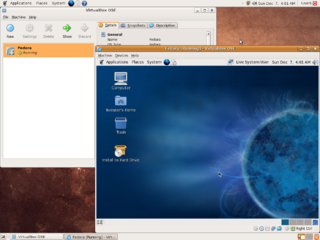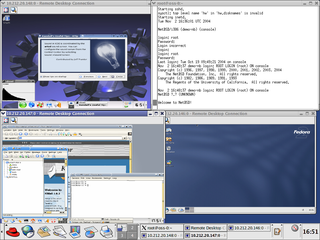
In computing, a virtual machine (VM) is the virtualization or emulation of a computer system. Virtual machines are based on computer architectures and provide the functionality of a physical computer. Their implementations may involve specialized hardware, software, or a combination of the two. Virtual machines differ and are organized by their function, shown here:

Xen is a free and open-source type-1 hypervisor, providing services that allow multiple computer operating systems to execute on the same computer hardware concurrently. It was originally developed by the University of Cambridge Computer Laboratory and is now being developed by the Linux Foundation with support from Intel, Citrix, Arm Ltd, Huawei, AWS, Alibaba Cloud, AMD, Bitdefender and EPAM Systems.
x86 virtualization is the use of hardware-assisted virtualization capabilities on an x86/x86-64 CPU.
A hypervisor, also known as a virtual machine monitor (VMM) or virtualizer, is a type of computer software, firmware or hardware that creates and runs virtual machines. A computer on which a hypervisor runs one or more virtual machines is called a host machine, and each virtual machine is called a guest machine. The hypervisor presents the guest operating systems with a virtual operating platform and manages the execution of the guest operating systems. Unlike an emulator, the guest executes most instructions on the native hardware. Multiple instances of a variety of operating systems may share the virtualized hardware resources: for example, Linux, Windows, and macOS instances can all run on a single physical x86 machine. This contrasts with operating-system–level virtualization, where all instances must share a single kernel, though the guest operating systems can differ in user space, such as different Linux distributions with the same kernel.

QEMU is a free and open-source emulator. It emulates a computer's processor through dynamic binary translation and provides a set of different hardware and device models for the machine, enabling it to run a variety of guest operating systems. It can interoperate with Kernel-based Virtual Machine (KVM) to run virtual machines at near-native speed. QEMU can also do emulation for user-level processes, allowing applications compiled for one processor architecture to run on another.
Platform virtualization software, specifically emulators and hypervisors, are software packages that emulate the whole physical computer machine, often providing multiple virtual machines on one physical platform. The table below compares basic information about platform virtualization hypervisors.

In computing, an input–output memory management unit (IOMMU) is a memory management unit (MMU) connecting a direct-memory-access–capable (DMA-capable) I/O bus to the main memory. Like a traditional MMU, which translates CPU-visible virtual addresses to physical addresses, the IOMMU maps device-visible virtual addresses to physical addresses. Some units also provide memory protection from faulty or malicious devices.

Oracle VirtualBox is a hosted hypervisor for x86 virtualization developed by Oracle Corporation. VirtualBox was originally created by InnoTek Systemberatung GmbH, which was acquired by Sun Microsystems in 2008, which was in turn acquired by Oracle in 2010.
Hardware virtualization is the virtualization of computers as complete hardware platforms, certain logical abstractions of their componentry, or only the functionality required to run various operating systems. Virtualization emulates the hardware environment of its host architecture, allowing multiple OSes to run unmodified and in isolation. At its origins, the software that controlled virtualization was called a "control program", but the terms "hypervisor" or "virtual machine monitor" became preferred over time.

Microsoft Hyper-V, codenamed Viridian, and briefly known before its release as Windows Server Virtualization, is a native hypervisor; it can create virtual machines on x86-64 systems running Windows. Starting with Windows 8, Hyper-V superseded Windows Virtual PC as the hardware virtualization component of the client editions of Windows NT. A server computer running Hyper-V can be configured to expose individual virtual machines to one or more networks. Hyper-V was first released with Windows Server 2008, and has been available without additional charge since Windows Server 2012 and Windows 8. A standalone Windows Hyper-V Server is free, but has a command-line interface only. The last version of free Hyper-V Server is Hyper-V Server 2019, which is based on Windows Server 2019.
Sun xVM was a product line from Sun Microsystems that addressed virtualization technology on x86 platforms. One component was discontinued before the Oracle acquisition of Sun; the remaining two continue under Oracle branding.

In computing, virtualization (v12n) is a series of technologies that allows dividing of physical computing resources into a series of virtual machines, operating systems, processes or containers.
Oracle VM Server for x86 is a server virtualization offering from Oracle Corporation. Oracle VM Server for x86 incorporates the free and open-source Xen hypervisor technology, supports Windows, Linux, and Solaris guests and includes an integrated Web based management console. Oracle VM Server for x86 features fully tested and certified Oracle Applications stack in an enterprise virtualization environment.
An embedded hypervisor is a hypervisor that supports the requirements of embedded systems.

libvirt is an open-source API, daemon and management tool for managing platform virtualization. It can be used to manage KVM, Xen, VMware ESXi, QEMU and other virtualization technologies. These APIs are widely used in the orchestration layer of hypervisors in the development of a cloud-based solution.

SeaBIOS is an open-source implementation of an x86 BIOS, serving as a freely available firmware for x86 systems. Aiming for compatibility, it supports standard BIOS features and calling interfaces that are implemented by a typical proprietary x86 BIOS. SeaBIOS can either run on bare hardware as a coreboot payload, or can be used directly in emulators such as QEMU and Bochs.
Second Level Address Translation (SLAT), also known as nested paging, is a hardware-assisted virtualization technology which makes it possible to avoid the overhead associated with software-managed shadow page tables.
Founded by Alex Vasilevsky, Virtual Computer was a venture-backed software company in the Boston area that produces desktop virtualization products, which combine centralized management with local execution on a hypervisor running on PCs. By running the workload on the PC, Virtual Computer enables companies to have centralized management without servers, storage, and networking required for server-hosted VDI.
GPU virtualization refers to technologies that allow the use of a GPU to accelerate graphics or GPGPU applications running on a virtual machine. GPU virtualization is used in various applications such as desktop virtualization, cloud gaming and computational science.
A system virtual machine is a virtual machine (VM) that provides a complete system platform and supports the execution of a complete operating system (OS). These usually emulate an existing architecture, and are built with the purpose of either providing a platform to run programs where the real hardware is not available for use, or of having multiple instances of virtual machines leading to more efficient use of computing resources, both in terms of energy consumption and cost effectiveness, or both. A VM was originally defined by Popek and Goldberg as "an efficient, isolated duplicate of a real machine".







